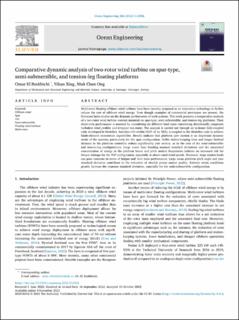| dc.contributor.author | El Beshbichi, Omar | |
| dc.contributor.author | Xing, Yihan | |
| dc.contributor.author | Ong, Muk Chen | |
| dc.date.accessioned | 2023-02-09T14:49:02Z | |
| dc.date.available | 2023-02-09T14:49:02Z | |
| dc.date.created | 2022-10-17T12:05:54Z | |
| dc.date.issued | 2022 | |
| dc.identifier.citation | El Beshbichi, O., Xing, Y., & Ong, M. C. (2022). Comparative dynamic analysis of two-rotor wind turbine on spar-type, semi-submersible, and tension-leg floating platforms. Ocean Engineering, 266, 112926. | en_US |
| dc.identifier.issn | 0029-8018 | |
| dc.identifier.uri | https://hdl.handle.net/11250/3049835 | |
| dc.description.abstract | Multi-rotor floating offshore wind turbines have been recently proposed as an innovative technology to further reduce the cost of offshore wind energy. Even though examples of commercial prototypes are present, the literature lacks studies on the dynamic performance of such systems. This work presents a comparative analysis of a two-rotor wind turbine concept mounted on spar-type, semi-submersible, and tension-leg platforms. Their short-term performance is assessed by considering six different load cases considering directionally congruent turbulent wind profiles and irregular sea states. The analysis is carried out through an in-house fully-coupled code developed in Modelica. AeroDyn v15 within FAST v8 by NREL is coupled to the Modelica code to achieve blade-element momentum capabilities. Results indicate that platform yaw motion is an important dynamic mode of the systems, particularly for the spar configuration. Stiffer station-keeping lines and longer fairlead distance to the platform centerline reduce significantly yaw motion, as in the case of the semi-submersible and tension-leg configurations. Large tower base bending moment standard deviations and the associated concentration of energy at the platform heave and pitch motion frequencies indicate an increased risk for fatigue damage for the TLP configuration, especially at above-rated wind speeds. Moreover, large tendon loads can pose concerns in terms of fatigue and limit state performance. Large mean platform pitch angle and yaw standard deviation contribute to the reduction of electric power output quality. Extreme storm conditions greatly increase the response standard deviation, especially for the semi-submersible configuration. | en_US |
| dc.language.iso | eng | en_US |
| dc.publisher | Elsevier | en_US |
| dc.rights | Navngivelse 4.0 Internasjonal | * |
| dc.rights.uri | http://creativecommons.org/licenses/by/4.0/deed.no | * |
| dc.title | Comparative dynamic analysis of two-rotor wind turbine on spar-type, semi-submersible, and tension-leg floating platforms | en_US |
| dc.title.alternative | Comparative dynamic analysis of two-rotor wind turbine on spar-type, semi-submersible, and tension-leg floating platforms | en_US |
| dc.type | Peer reviewed | en_US |
| dc.type | Journal article | en_US |
| dc.description.version | publishedVersion | en_US |
| dc.rights.holder | The authors | en_US |
| dc.subject.nsi | VDP::Teknologi: 500 | en_US |
| dc.source.journal | Ocean Engineering | en_US |
| dc.identifier.doi | 10.1016/j.oceaneng.2022.112926 | |
| dc.identifier.cristin | 2061953 | |
| cristin.ispublished | true | |
| cristin.fulltext | original | |
| cristin.qualitycode | 1 | |

